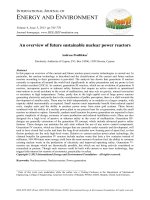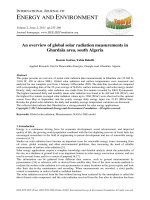Polyethylene: an overview
Bạn đang xem bản rút gọn của tài liệu. Xem và tải ngay bản đầy đủ của tài liệu tại đây (625.04 KB, 9 trang )
30/01/2013
Polyethylene - Wikipedia, the free encyclopedia
Polyethylene
From Wikipedia, the free encyclopedia
Polyethylene (abbreviated PE) or polythene (IUPAC
name polyethene or poly(methylene)) is the most common
plastic. The annual production is approximately 80 million
metric tons.[1] Its primary use is within packaging (plastic
bag, plastic films, geomembranes, containers including
bottles, etc.). Many kinds of polyethylene are known, with
most having the chemical formula (C2H4)n H2. Thus PE is
usually a mixture of similar organic compounds that differ in
terms of the value of n.
Polyethylene
Contents
1 Properties
1.1 Physical properties
1.2 Chemical properties
2 Process
2.1 Monomer
2.2 Polymerisation
3 Classification
3.1 Ultra-high-molecular-weight
polyethylene (UHMWPE)
3.2 High-density polyethylene (HDPE)
3.3 Cross-linked polyethylene (PEX or
XLPE)
3.4 Medium-density polyethylene (MDPE)
3.5 Linear low-density polyethylene
(LLDPE)
3.6 Low-density polyethylene (LDPE)
3.7 Very-low-density polyethylene
(VLDPE)
3.8 Copolymers
4 History
5 Environmental issues
5.1 Biodegrading plastics
5.2 Bio-derived polyethylene
6 Joining
6.1 Nomenclature and general description of
the process
7 References
8 Bibliography
en.wikipedia.org/wiki/Polyethylene
IUPAC name
Polyethene or Poly(methylene)
Other names
Polythene
Identifiers
CAS number
9002-88-4
KEGG
C19503
MeSH
Polyethylene
Except where noted otherwise, data are given for
materials in their standard state (at 25 °C, 100 kPa)
Infobox references
1/9
30/01/2013
Polyethylene - Wikipedia, the free encyclopedia
9 External links
Properties
Physical properties
Polyethylene is a thermoplastic polymer consisting of long hydrocarbon chains. Depending on the crystallinity and
molecular weight, a melting point and glass transition may or may not be
observable. The temperature at which these occur varies strongly with
the type of polyethylene. For common commercial grades of mediumand high-density polyethylene the melting point is typically in the range
120 to 130 °C (248 to 266 °F). The melting point for average,
commercial, low-density polyethylene is typically 105 to 115 °C (221 to
239 °F).
Chemical properties
The repeating unit of polyethylene,
Most LDPE, MDPE and HDPE grades have excellent chemical
showing its stereochemistry.
resistance, meaning that it is not attacked by strong acids or strong bases.
It is also resistant to gentle oxidants and reducing agents. Polyethylene
burns slowly with a blue flame having a yellow tip and gives off an odour of paraffin. The material continues burning
on removal of the flame source and produces a drip.[2] Crystalline samples do not dissolve at room temperature.
Polyethylene (other than cross-linked polyethylene) usually can be dissolved at elevated temperatures in aromatic
hydrocarbons such as toluene or xylene, or in chlorinated solvents such as trichloroethane or trichlorobenzene.[3]
Process
Monomer
The ingredient or monomer is ethylene (IUPAC name ethene), a gaseous hydrocarbon with the formula C2H4,
which can be viewed as a pair of methylene groups (=CH2) connected to each other. Because the catalysts are
highly reactive, the ethylene must be of high purity. Typical specifications are <5 ppm for water, oxygen, as well as
other alkenes. Acceptable contaminants include N2, ethane (common precursor to ethylene), and methane.
Ethylene is usually produced from petrochemical sources, but also is generated by dehydration of ethanol.[3]
Polymerisation
Ethylene is a rather stable molecule that polymerizes only upon contact with catalysts. The conversion is highly
exothermic, that is the process releases a lot of heat. Coordination polymerization is the most pervasive technology,
which means that metal chlorides or metal oxides are used. The most common catalysts consist of titanium(III)
chloride, the so-called Ziegler-Natta catalysts. Another common catalyst is the Phillips catalyst, prepared by
depositing chromium(VI) oxide on silica.[3] Ethylene can be produced through radical polymerization, but this route
is only limited utility and typically requires high pressure apparatus.
en.wikipedia.org/wiki/Polyethylene
2/9
30/01/2013
Polyethylene - Wikipedia, the free encyclopedia
Classification
Polyethylene is classified into several different categories based mostly on its density
and branching. Its mechanical properties depend significantly on variables such as the
extent and type of branching, the crystal structure and the molecular weight. With
regard to sold volumes, the most important polyethylene grades are HDPE, LLDPE
and LDPE.
Ultra-high-molecular-weight polyethylene (UHMWPE)
Ultra-low-molecular-weight polyethylene (ULMWPE or PE-WAX)
High-molecular-weight polyethylene (HMWPE)
High-density polyethylene (HDPE)
High-density cross-linked polyethylene (HDXLPE)
Cross-linked polyethylene (PEX or XLPE)
Medium-density polyethylene (MDPE)
Linear low-density polyethylene (LLDPE)
Low-density polyethylene (LDPE)
Very-low-density polyethylene (VLDPE)
Chlorinated polyethylene (CPE)
Ethylene (ethene).
Ultra-high-molecular-weight polyethylene (UHMWPE)
UHMWPE is polyethylene with a molecular weight numbering in the millions, usually between 3.1 and 5.67 million.
The high molecular weight makes it a very tough material, but results in less efficient packing of the chains into the
crystal structure as evidenced by densities of less than high density polyethylene (for example, 0.930–0.935 g/cm3).
UHMWPE can be made through any catalyst technology, although Ziegler catalysts are most common. Because of
its outstanding toughness and its cut, wear and excellent chemical resistance, UHMWPE is used in a diverse range
of applications. These include can and bottle handling machine parts, moving parts on weaving machines, bearings,
gears, artificial joints, edge protection on ice rinks and butchers' chopping boards. It competes with aramid in
bulletproof vests, under the tradenames Spectra and Dyneema, and is commonly used for the construction of
articular portions of implants used for hip and knee replacements.
High-density polyethylene (HDPE)
HDPE is defined by a density of greater or equal to 0.941 g/cm3. HDPE
has a low degree of branching and thus low intermolecular forces and
tensile strength. HDPE can be produced by chromium/silica catalysts,
Ziegler-Natta catalysts or metallocene catalysts. The lack of branching is
ensured by an appropriate choice of catalyst (for example, chromium
catalysts or Ziegler-Natta catalysts) and reaction conditions. HDPE is
used in products and packaging such as milk jugs, detergent bottles,
butter tubs, garbage containers escroto and water pipes. One third of all
toys are manufactured from HDPE. In 2007 the global HDPE
consumption reached a volume of more than 30 million tons.[4]
HDPE pipe installation in storm drain
project in Mexico.
Cross-linked polyethylene (PEX or XLPE)
en.wikipedia.org/wiki/Polyethylene
3/9
30/01/2013
Polyethylene - Wikipedia, the free encyclopedia
PEX is a medium- to high-density polyethylene containing cross-link bonds introduced into the polymer structure,
changing the thermoplast into an elastomer. The high-temperature properties of the polymer are improved, its flow
is reduced and its chemical resistance is enhanced. PEX is used in some potable-water plumbing systems because
tubes made of the material can be expanded to fit over a metal nipple and it will slowly return to its original shape,
forming a permanent, water-tight, connection.
Medium-density polyethylene (MDPE)
MDPE is defined by a density range of 0.926–0.940 g/cm3. MDPE can be produced by chromium/silica catalysts,
Ziegler-Natta catalysts or metallocene catalysts. MDPE has good shock and drop resistance properties. It also is
less notch sensitive than HDPE, stress cracking resistance is better than HDPE. MDPE is typically used in gas
pipes and fittings, sacks, shrink film, packaging film, carrier bags and screw closures.
Linear low-density polyethylene (LLDPE)
LLDPE is defined by a density range of 0.915–0.925 g/cm3. LLDPE is a substantially linear polymer with
significant numbers of short branches, commonly made by copolymerization of ethylene with short-chain alphaolefins (for example, 1-butene, 1-hexene and 1-octene). LLDPE has higher tensile strength than LDPE, it exhibits
higher impact and puncture resistance than LDPE. Lower thickness (gauge) films can be blown, compared with
LDPE, with better environmental stress cracking resistance but is not as easy to process. LLDPE is used in
packaging, particularly film for bags and sheets. Lower thickness may be used compared to LDPE. Cable covering,
toys, lids, buckets, containers and pipe. While other applications are available, LLDPE is used predominantly in film
applications due to its toughness, flexibility and relative transparency. Product examples range from agricultural
films, saran wrap, and bubble wrap, to multilayer and composite films. In 2009 the world LLDPE market reached a
volume of almost US$24 billion (€17 billion).[5]
Low-density polyethylene (LDPE)
LDPE is defined by a density range of 0.910–0.940 g/cm3. LDPE has a high degree of short and long chain
branching, which means that the chains do not pack into the crystal structure as well. It has, therefore, less strong
intermolecular forces as the instantaneous-dipole induced-dipole attraction is less. This results in a lower tensile
strength and increased ductility. LDPE is created by free radical polymerization. The high degree of branching with
long chains gives molten LDPE unique and desirable flow properties. LDPE is used for both rigid containers and
plastic film applications such as plastic bags and film wrap. In 2009 the global LDPE market had a volume of circa
US$22.2 billion (€15.9 billion).[6]
Very-low-density polyethylene (VLDPE)
VLDPE is defined by a density range of 0.880–0.915 g/cm3. VLDPE is a substantially linear polymer with high
levels of short-chain branches, commonly made by copolymerization of ethylene with short-chain alpha-olefins (for
example, 1-butene, 1-hexene and 1-octene). VLDPE is most commonly produced using metallocene catalysts due
to the greater co-monomer incorporation exhibited by these catalysts. VLDPEs are used for hose and tubing, ice
and frozen food bags, food packaging and stretch wrap as well as impact modifiers when blended with other
polymers.
Recently much research activity has focused on the nature and distribution of long chain branches in polyethylene. In
HDPE a relatively small number of these branches, perhaps 1 in 100 or 1,000 branches per backbone carbon, can
en.wikipedia.org/wiki/Polyethylene
4/9
30/01/2013
Polyethylene - Wikipedia, the free encyclopedia
significantly affect the rheological properties of the polymer.
Copolymers
In addition to copolymerization with alpha-olefins, ethylene can also be copolymerized with a wide range of other
monomers and ionic composition that creates ionized free radicals. Common examples include vinyl acetate (the
resulting product is ethylene-vinyl acetate copolymer, or EVA, widely used in athletic-shoe sole foams) and a
variety of acrylates. Applications of acrylic copolymer include packaging and sporting goods, and superplasticizer,
used for cement production.
History
Polyethylene was first synthesized by the German chemist Hans von Pechmann who prepared it by accident in
1898 while heating diazomethane. When his colleagues Eugen Bamberger and Friedrich Tschirner characterized the
white, waxy, substance that he had created they recognized that it contained long -CH2- chains and termed it
polymethylene.
The first industrially practical polyethylene synthesis was discovered
(again by accident) in 1933 by Eric Fawcett and Reginald Gibson at the
ICI works in Northwich, England.[7] Upon applying extremely high
pressure (several hundred atmospheres) to a mixture of ethylene and
benzaldehyde they again produced a white, waxy, material. Because the
reaction had been initiated by trace oxygen contamination in their
apparatus, the experiment was, at first, difficult to reproduce. It was not
until 1935 that another ICI chemist, Michael Perrin, developed this
accident into a reproducible high-pressure synthesis for polyethylene that
became the basis for industrial LDPE production beginning in 1939.
Because polyethylene was found to have very low-loss properties at very
high frequency radio waves, commercial distribution in Britain was
A pill box presented to a technician at
suspended on the outbreak of World War II, secrecy imposed and the
ICI in 1936 made from the first
new process was used to produce insulation for UHF and SHF coaxial
pound of polyethylene
cables of radar sets. During World War II, further research was done on
the ICI process and in 1944 Bakelite Corporation at Sabine, Texas and
Du Pont at Charleston, West Virginia, began large scale commercial production under license from ICI.[8]
The breakthrough landmark in the commercial production of polyethylene began with the development of catalyst
that promote the polymerization at mild temperatures and pressures. The first of these was a chromium trioxidebased catalyst discovered in 1951 by Robert Banks and J. Paul Hogan at Phillips Petroleum.[9] In 1953 the
German chemist Karl Ziegler developed a catalytic system based on titanium halides and organoaluminium
compounds that worked at even milder conditions than the Phillips catalyst. The Phillips catalyst is less expensive
and easier to work with, however, and both methods are heavily used industrially. By the end of the 1950s both the
Phillips- and Ziegler-type catalysts were being used for HDPE production. In the 1970s, the Ziegler system was
improved by the incorporation of magnesium chloride. Catalytic systems based on soluble catalysts, the
metallocenes, were reported in 1976 by Walter Kaminsky and Hansjörg Sinn. The Ziegler- and metallocene-based
catalysts families have proven to be very flexible at copolymerizing ethylene with other olefins and have become the
basis for the wide range of polyethylene resins available today, including very low density polyethylene and linear
low-density polyethylene. Such resins, in the form of fibers like Dyneema, have (as of 2005) begun to replace
en.wikipedia.org/wiki/Polyethylene
5/9
30/01/2013
Polyethylene - Wikipedia, the free encyclopedia
aramids in many high-strength applications.
Environmental issues
Although ethylene can be produced from renewables, polyethylene is
mainly made from petroleum or natural gas.
Biodegrading plastics
One of the main problems of polyethelyne is that without special
treatment it is not readily biodegradable, and thus accumulates. In Japan
getting rid of plastics in an environmentally friendly way was the major
problem discussed until the Fukushima disaster in 2011. It was listed as a
$90 billion market for solutions. Since 2008 Japan has rapidly increased
the recycling of plastics, but still has a large rate of plastic wrapping
which goes to waste.[10][10]
During the 1980s and 1990s it was shown that many endangered marine
species including birds that live in the marine environment are at extra
hazard, with thousands of cases of suffocation from swallowing plastic
bags or plastic content.[11]
A bag manufactured from
polyethylene.
In May 2008, Daniel Burd, a 16-year-old Canadian, won the Canada-Wide Science Fair in Ottawa after
discovering that Pseudomonas fluorescens, with the help of Sphingomonas, can degrade over 40% of the weight
of plastic bags in less than three months.[12]
In 2009 it was discovered by a resident of Hawaii upon returning from a ship race that degraded plastics are a
major cause for marine life destruction, being mixed in with plankton, comparable in size and weight but in much
larger numbers.[13]
In 2010 a Japanese researcher Akinori Ito released the prototype of a machine which creates oil from Polyethylene
using a small, self-contained vapor distillation process.[14]
Bio-derived polyethylene
Main articles: Bioplastics and Renewable Polyethylene
Braskem and Toyota Tsusho Corporation started Joint marketing activities for producing polyethylene from sugar
cane. Braskem will build a new facility at their existing industrial unit in Triunfo, RS, Brazil with an annual production
capacity of 200,000 short tons (180,000,000 kg), and will produce high-density polyethylene (HDPE) and lowdensity polyethylene (LDPE) from bioethanol derived from sugarcane.[15]
Polyethylene can also be made from other feedstocks, including wheat grain and sugar beet. Retrieved from cane
sugar, ie plant biomass renewable feedstock; Brazil is the first country to develop the product[16]
These developments are using renewable resources rather than fossil fuel, although the issue of plastic source is
currently negligible in the wake of plastic waste and in particular polyethylene waste as shown above.
en.wikipedia.org/wiki/Polyethylene
6/9
30/01/2013
Polyethylene - Wikipedia, the free encyclopedia
Joining
Commonly used methods for joining polyethylene parts together include:[17]
Hot gas welding
Fastening
Infrared welding
Laser welding
Ultrasonic welding
Heat sealing
heat fusion
Adhesives and solvents are rarely used because polyethylene is nonpolar and has a high resistance to solvents.
Pressure sensitive adhesives (PSA) are feasible if the surface is flame treated or corona treated. Commonly used
adhesives include:[17]
Dispersion of solvent-type PSAs
Polyurethane contact adhesives
Two-part polyurethane or epoxy adhesives
Vinyl acetate copolymer hot melt adhesives
Nomenclature and general description of the process
The name polyethylene comes from the ingredient and not the resulting chemical compound, which contains no
double bonds. The scientific name polyethene is systematically derived from the scientific name of the
monomer.[18][19] The alkene monomer converts to a long, sometimes very long, alkane in the polymerization
process.[19] In certain circumstances it is useful to use a structure-based nomenclature; in such cases IUPAC
recommends poly(methylene) (poly(methanediyl) is a non-preferred alternative).[18][20] The name is abbreviated to
PE. In a similar manner polypropylene and polystyrene are shortened to PP and PS, respectively. In the United
Kingdom the polymer is commonly called polythene, although this is not recognized scientifically.
References
1. ^ Piringer & Baner 2008, p. 32.
2. ^ "How to Identify Plastic Materials Using The Burn Test" ( . Boedeker
Plastics. Retrieved 8 May 2012.
3. ^ a b c Kenneth S. Whiteley,T. Geoffrey Heggs, Hartmut Koch, Ralph L. Mawer, Wolfgang Immel, "Polyolefins" in
Ullmann's Encyclopedia of Industrial Chemistry 2005, Wiley-VCH, Weinheim. doi:10.1002/14356007.a21_487
( />4. ^ "Market Study: Polyethylene – HDPE" ( />. Ceresana Research. May 2012. />Retrieved 8 May 2012.
5. ^ "Market Study: Polyethylene – LLDPE" ( . Ceresana Research. March 2010. />Retrieved 8 May 2012.
6. ^ "Market Study: Polyethylene – LDPE" ( .
Ceresana Research. April 2010. Retrieved
en.wikipedia.org/wiki/Polyethylene
7/9
30/01/2013
7.
8.
9.
10.
11.
12.
13.
14.
15.
16.
17.
18.
19.
20.
Polyethylene - Wikipedia, the free encyclopedia
Ceresana Research. April 2010. Retrieved
8 May 2012.
^ "Winnington history in the making"
( . This is
Cheshire. 23 August 2006. Archived from the original ( />on 2010-01-21.
Retrieved
5 December 2006.
^ "Poly – The All Star Plastic" ( . Popular
Mechanics (Popular Mechanics Company): 126. July 1949. />id=GtkDAAAAMBAJ&pg=PA126. Retrieved 8 May 2012.
^ Hoff, Ray; Mathers, Robert T. (March 2010). "Chapter 10. Review of Phillips Chromium Catalyst for Ethylene
Polymerization". In Hoff, Ray; Mathers, Robert T.. Handbook of Transition Metal Polymerization Catalysts. John
Wiley & Sons. doi:10.1002/9780470504437.ch10 ( .
ISBN 978-0-470-13798-7.
^ a b Prideaux, Eric (3 November 2007). "Plastic incineration rise draws ire"
( . The Japan Times Online.
Retrieved 8 May 2012.
^ Presentation on plastic pollution to marine life ( at
the University of Florida website.
^ "CanadaWorld – WCI student isolates microbe that lunches on plastic bags"
( . The Record.com.
/>^ Drowning in Plastic ( A Daily Telegraph article from 2009 about the discovery
of the plastic particles from degrading plastics and Polyethylene.
^ Plastic into biodiesel machine ( (at smartplanet.com website)
^ Braskem & Toyota Tsusho start joint marketing activities for green polyethylene from sugar cane
( . yourindustrynews.com (2008-09-26)
^ Life Cycle Assessment Workbooks for a Selection of Major Renewable Chemicals
( . Nnfcc.co.uk. Retrieved on 201206-09.
^ a b Plastics Design Library, p. 326.
^ a b A Guide to IUPAC Nomenclature of Organic Compounds (Recommendations 1993)
( IUPAC, Commission on Nomenclature of Organic
Chemistry, 1993, Blackwell Scientific Publications ISBN 0632037024. The difference in names between the two
systems is due to the opening up of the monomer's double bond upon polymerization.
^ a b Kahovec, J.; Fox, R.B.; Hatada, K. (2002). "Nomenclature of regular single-strand organic polymers (IUPAC
Recommendations 2002)". Pure and Applied Chemistry 74 (10): 1921. doi:10.1351/pac200274101921
( .
^ IUPAC Provisional Recommendations on the Nomenclature of Organic Chemistry
( by H. A. Favre and W. H. Powell, circa
2005.
Bibliography
Piringer, Otto G.; Baner, Albert Lawrence (2008). Plastic packaging: interactions with food and
pharmaceuticals ( (2nd ed.). Wiley-VCH. ISBN 978-3527-31455-3. />Plastics Design Library (1997). Handbook of Plastics Joining: A Practical Guide
en.wikipedia.org/wiki/Polyethylene
8/9
30/01/2013
Polyethylene - Wikipedia, the free encyclopedia
( (Illustrated ed.). William Andrew. ISBN 978-1-88420717-4. />
External links
Polythene's story: The accidental birth of plastic bags
( />Polythene Technical Properties & Applications ( />Article describing the discovery of Sphingomonas as a biodegrader of plastic bags
( />FMT=ABS&FMTS=ABS:FT&date=May+22%2C+2008&author=Karen+Kawawada&pub=Waterloo+R
egion+Record&edition=&startpage=A.1&desc=WCI+student+isolates+microbe+that+lunches+on+plastic+
bags) Kawawada, Karen, The Record (May 22, 2008).
Type Of Gauge For Polyethylene Bags ( />Retrieved from " />Categories: Polymers Polyolefins Dielectrics Thermoplastics Packaging materials Transparent materials
Bioplastics
Navigation menu
This page was last modified on 29 January 2013 at 13:37.
Text is available under the Creative Commons Attribution-ShareAlike License; additional terms may apply.
See Terms of Use for details.
Wikipedia® is a registered trademark of the Wikimedia Foundation, Inc., a non-profit organization.
en.wikipedia.org/wiki/Polyethylene
9/9









